Data and Sounds from psychoacoustic experiments
"The dependency of timbre of musical on fundamental frequency "
download here the submited version of the article
Summary: Goal, Stimuli,
Results: Exp. I, Exp. II, Exp. III
Goal:
The dependency of the timbre of musical sounds
on their fundamental frequency (F0) was examined through three timbre
dissimilarity experiments. In the first experiment (Exp. I), subjects judged
timbre dissimilarity between pairs of stimuli produced by a set of twelve
musical instruments with equal F0, duration and loudness. There were
three sessions, each at a different F0 (Exp. Ia at B2, 247 Hz; Exp.
Ib at C#3, 277 Hz, and Exp. Ic at Bb3, 466 Hz). In the second experiment
(Exp II) the same stimuli were rearranged in pairs always having the same
difference in F0. There were two sessions, each involving a different
magnitude of F0 difference (Exp. IIa : B2 with C#3, Exp. IIb B2 with
Bb3), and subjects were instructed to ignore the difference in pitch. In
the third experiment, a subset of the same instruments were paired both with
and without an F0 difference, and all pairs were presented within the
same session. There were two sessions, each involving the same different magnitude
of F0 difference, as in Experiment II (Exp. IIIa : B2 with C#3, Exp.
IIIb B2 with Bb3). Experiment 1 produced dissimilarity matrices that were
similar at different F0 s, suggesting that the relative positions
of instruments within timbre space varied little with changes in F0.
Experiment 2 produced dissimilarity matrices that were symmetrical, suggesting
further that absolute displacements within timbre space are also small, at
least compared to between-instrument dissimilarities. Patterns of dissimilarity
were similar with or without an F0 difference, showing that subjects
could ignore a constant difference in pitch when making timbre dissimilarity
judgments. Experiment 3 extended this result to the case where the stimulus
set included pairs both with and without an F0 difference, showing
that subjects could ignore a variable difference in pitch. Dissimilarity
scores were also subjected to multidimensional scaling, and produced solutions
(timbre spaces) that varied little across conditions and experiments. Taken
together, the results suggest that the perception of timbre is relatively
independent from pitch at least with pitch difference smaller than an octave,
and can be abstracted across differences in fundamental frequency.
Stimuli:
Ten natural and two synthetic instruments were
used. Each instrument was played at three notes: B2 (247 Hz), C#3 (277 Hz)
and Bb3 (466 Hz), chosen to explore the effects of a small difference (two
semitones) and a moderate difference (eleven semitones) of F0. Natural
instrument samples were extracted from the
Studio On Line (SOL) database of Ircam : a guitar (B2 was played on the
E string, C#3 on the A string, and Bb3 on the D string), a harp, a violin
pizzicato (the B2 and the C#3 notes were played on the G string, the Bb3
on the D string), a bowed violin (strings were the same as for the violin
pizzicato), a bowed double bass (all notes were played on the G string),
an oboe, a clarinet, a flute, a horn in F, a trumpet in C. In the following,
these instruments will be abbreviated as Gu, Hr, Vp, Vl, Ba, Ob, Cl, Fl,
Ho, Tr, respectively. In addition to these natural instruments, two synthetic
instruments were built with the help of the analysis/synthesis programs ADDITIVE.
A natural saxophone note (B2, mezzo forte) was analyzed to estimate the time-varying
spectral envelope of the harmonic partials (the residual inharmonic part
was discarded). Based on this envelope three sounds were produced, at B2,
C#3 and Bb3. This instrument was named 'SA'. A second instrument was created
by stretching the same spectrotemporal envelope along the frequency axis
by a ratio of 1.89, corresponding to the F0 ratio between B2 and Bb3.
This was used to synthesize three sounds at B2, C#3 and Bb3. This instrument
was named 'SB'. The spectrum of SB at Bb3 is a dilated version of the spectrum
of SA at B2 (partials of same rank have the same amplitude). Thus, the stimulus
set contains two stimuli that share the same spectrotemporal envelope in
terms of rank across F0, as well as several that share the same envelope
in terms of frequency. All stimuli were clipped to the same duration of 1.5
s by applying a 200 ms cosinusoidal offset ramp after 1.3 s. Amplitudes were
adjusted to obtain equal subjective loudness when the stimuli were presented
at approximately 60 dB SPL. Stimuli were sampled at a rate of 44100 Hz, and
presented diotically over Sennheiser 520 II headphones.
Results:
Exp. I:
Stimuli compared pairwise with the same F0.
One F0 per matrix, 24 subjects, 12 stimuli (66 pairs)
-> matrix 12 X 66, one subject per line, pairs are set as follow:
| Instrument |
Gu |
Hr |
Vp |
Vl |
Bs |
SA |
SB |
Ob |
Cl |
Fl |
Ho |
Tr |
| Guitar |
. |
. |
. |
. |
. |
. |
. |
. |
. |
. |
. |
. |
| Harp |
1 |
. |
. |
. |
. |
. |
. |
. |
. |
. |
. |
. |
| Violin Pizz. |
2 |
3 |
. |
. |
. |
. |
. |
. |
. |
. |
. |
. |
| Violin Bowed |
4 |
5 |
6 |
. |
. |
. |
. |
. |
. |
. |
. |
. |
| Bass |
7 |
8 |
9 |
10 |
. |
. |
. |
. |
. |
. |
. |
. |
| Synth A |
11 |
12 |
13 |
14 |
15 |
. |
. |
. |
. |
. |
. |
. |
| Synth B |
16 |
17 |
18 |
19 |
20 |
21 |
. |
. |
. |
. |
. |
. |
| Oboe |
22 |
23 |
24 |
25 |
26 |
27 |
28 |
. |
. |
. |
. |
. |
| Clarinet |
29 |
30 |
31 |
32 |
33 |
34 |
35 |
36 |
. |
. |
. |
. |
| Flute |
37 |
38 |
39 |
40 |
41 |
42 |
43 |
44 |
45 |
. |
. |
. |
| Horn |
46 |
47 |
48 |
49 |
50 |
51 |
52 |
53 |
54 |
55 |
. |
. |
| Trumpet |
56 |
57 |
58 |
59 |
60 |
61 |
62 |
63 |
64 |
65 |
66 |
. |
download :
- the matrix for Exp. Ia (F0 at B2): here
- the matrix for Exp. Ib (F0 at C#3): here
- the matrix for Exp. Ic (F0 at Bb3): here
MDS solution:
A two dimensional space with specificities, (two classes of subject) was
found with the help Clascal Software
Space Exp. 1a
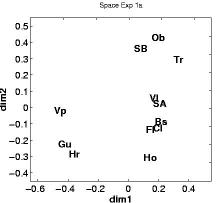
|
Space Exp. 1b

|
Space Exp. 1c
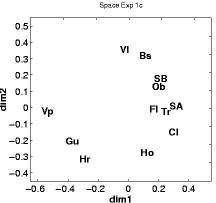
|
The data are written in a matrix 12 X 3 set as follow:
| Instrument |
Dimension 1 |
Dimension 2 |
Specificities |
| Guitar |
. |
. |
. |
| Harp |
. |
. |
. |
| Violin Pizz. |
. |
. |
. |
| Violin Bowed |
. |
. |
. |
| Bass |
. |
. |
. |
| Synth A |
. |
. |
. |
| Synth B |
. |
. |
. |
| Oboe |
. |
. |
. |
| Clarinet |
. |
. |
. |
| Flute |
. |
. |
. |
| Horn |
. |
. |
. |
| Trumpet |
. |
. |
. |
download :
- the MDS space for Exp. Ia (F0 at B2): here
- the MDS space for Exp. Ib (F0 at C#3): here
- the MDS space for Exp. Ic (F0 at Bb3): here
Exp. II:
Stimuli compared pairwise with the same difference of F0.
Two F0s per matrix, 24 subjects, 12 stimuli (144 pairs)
-> matrix 12 X 144, one subject per line, pairs are set as follow:
| F0_2 \ F0_1 |
Gu |
Hr |
Vp |
Vl |
Bs |
SA |
SB |
Ob |
Cl |
Fl |
Ho |
Tr |
| Guitar |
1 |
2 |
3 |
4 |
5 |
6 |
7 |
8 |
9 |
10 |
11 |
12 |
| Harp |
13 |
14 |
15 |
16 |
17 |
18 |
19 |
20 |
21 |
22 |
23 |
24 |
| Violin Pizz. |
25 |
26 |
27 |
28 |
29 |
30 |
31 |
32 |
33 |
34 |
35 |
36 |
| Violin Bowed |
37 |
38 |
39 |
40 |
41 |
42 |
43 |
44 |
45 |
46 |
47 |
48 |
| Bass |
49 |
50 |
51 |
52 |
53 |
54 |
55 |
56 |
57 |
58 |
59 |
60 |
| Synth A |
61 |
62 |
63 |
64 |
65 |
66 |
67 |
68 |
69 |
70 |
71 |
72 |
| Synth B |
73 |
74 |
75 |
76 |
77 |
78 |
79 |
80 |
81 |
82 |
83 |
84 |
| Oboe |
85 |
86 |
87 |
88 |
89 |
90 |
91 |
92 |
93 |
94 |
95 |
96 |
| Clarinet |
97 |
98 |
99 |
100 |
101 |
102 |
103 |
104 |
105 |
106 |
107 |
108 |
| Flute |
109 |
110 |
111 |
112 |
113 |
114 |
115 |
116 |
117 |
118 |
119 |
120 |
| Horn |
121 |
122 |
123 |
124 |
125 |
126 |
127 |
128 |
129 |
130 |
131 |
132 |
| Trumpet |
133 |
134 |
135 |
136 |
137 |
138 |
139 |
140 |
141 |
142 |
143 |
144 |
download :
- the matrix for Exp. IIa (F0 at B2-C#3): here
- the matrix for Exp. IIb (F0 at B2- Bb3): here
Exp. III:
Stimuli compared pairwise with or without a difference of F0.
Two F0s per matrix, 22 subjects for Exp. IIIa, 18 for Exp. IIIb,
18 stimuli (156 pairs) -> matrix 22 (or 18) X 153, one subject per line,
pairs are set as follow:
| Instrument |
Gu 1 |
Hr 1 |
Vp 1 |
Vl 1 |
SA 1 |
Ob 1 |
Cl 1 |
Ho 1 |
Tr 1 |
Gu 2 |
Hr 2 |
Vp 2 |
Vl 2 |
SA 2 |
Ob 2 |
Cl 2 |
Ho 2 |
Tr 2 |
| Guitar 1 |
. |
. |
. |
. |
. |
. |
. |
. |
. |
. |
. |
. |
. |
. |
. |
. |
. |
. |
| Harp 1 |
1 |
. |
. |
. |
. |
. |
. |
. |
. |
. |
. |
. |
. |
. |
. |
. |
. |
. |
| Violin P. 1 |
2 |
3 |
. |
. |
. |
. |
. |
. |
. |
. |
. |
. |
. |
. |
. |
. |
. |
. |
| Violin B. 1 |
4 |
5 |
6 |
. |
. |
. |
. |
. |
. |
. |
. |
. |
. |
. |
. |
. |
. |
. |
| Synth A 1 |
7 |
8 |
9 |
10 |
. |
. |
. |
. |
. |
. |
. |
. |
. |
. |
. |
. |
. |
. |
| Oboe 1 |
11 |
12 |
13 |
14 |
15 |
. |
. |
. |
. |
. |
. |
. |
. |
. |
. |
. |
. |
. |
| Clarinet 1 |
16 |
17 |
18 |
19 |
20 |
21 |
. |
. |
. |
. |
. |
. |
. |
. |
. |
. |
. |
. |
| Horn 1 |
22 |
23 |
24 |
25 |
26 |
27 |
28 |
. |
. |
. |
. |
. |
. |
. |
. |
. |
. |
. |
| Trumpet 1 |
29 |
30 |
31 |
32 |
33 |
34 |
35 |
36 |
. |
. |
. |
. |
. |
. |
. |
. |
. |
. |
| Guitar 2 |
37 |
38 |
39 |
40 |
41 |
42 |
43 |
44 |
45 |
. |
. |
. |
. |
. |
. |
. |
. |
. |
| Harp 2 |
46 |
47 |
48 |
49 |
50 |
51 |
52 |
53 |
54 |
55 |
. |
. |
. |
. |
. |
. |
. |
. |
| Violin P. 2 |
56 |
57 |
58 |
59 |
60 |
61 |
62 |
63 |
64 |
65 |
66 |
. |
. |
. |
. |
. |
. |
. |
| Violin B. 2 |
67 |
68 |
69 |
70 |
71 |
72 |
73 |
74 |
75 |
76 |
77 |
78 |
. |
. |
. |
. |
. |
. |
| Synth A 2 |
79 |
80 |
81 |
82 |
83 |
84 |
85 |
86 |
87 |
88 |
89 |
90 |
91 |
. |
. |
. |
. |
. |
| Oboe 2 |
92 |
93 |
94 |
95 |
96 |
97 |
98 |
99 |
100 |
101 |
102 |
103 |
104 |
105 |
. |
. |
. |
. |
| Clarinet 2 |
106 |
107 |
108 |
109 |
110 |
111 |
112 |
113 |
114 |
115 |
116 |
117 |
118 |
119 |
120 |
. |
. |
. |
| Horn 2 |
121 |
122 |
123 |
124 |
125 |
126 |
127 |
128 |
129 |
130 |
131 |
132 |
133 |
134 |
135 |
136 |
. |
. |
| Trumpet 2 |
137 |
138 |
139 |
140 |
141 |
142 |
143 |
144 |
145 |
146 |
147 |
148 |
149 |
150 |
151 |
152 |
153 |
. |
download :
- the matrix for Exp. IIIa (F0 at B2-C#3): here
- the matrix for Exp. IIIb (F0 at B2- Bb3): here
MDS solution
A four-dimensional space without specificities, (one class of subject)
was found for the Exp. IIIa,
and a four dimensional space without specificities, (one class of subject)
was found for the Exp. IIIb.
The point represents the position of the instrument at the low F0
(B2), the end of line represents the position of the same instrument at high
F0 (C#3 for Exp. IIIa, Bb3 for Exp. IIIb).
Space Exp. IIIa dim1 versus dim2 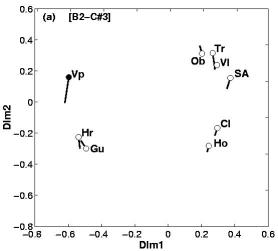
|
Space Exp. IIIa dim3 versus dim4 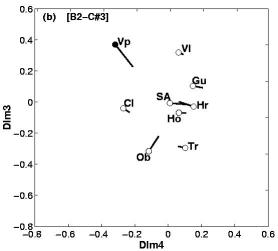
|
Space Exp. IIIb dim1 versus dim2 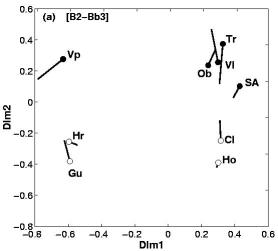
|
Space Exp. IIIb dim3 versus dim4 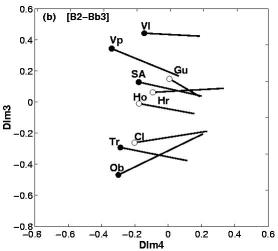
|
download :
- the MDS space for Exp. IIIa (F0 at B2-C#3): here
- the MDS space for Exp. IIIb (F0 at B2-Bb3): here
Matrix space are in the size 18 X 3 (for Exp. IIIa) and 18 X 4 (for
Exp IIIb). There is one instrument per row (the order are the same as the
above matrix), and one dimension per column.









